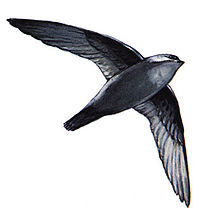Chimney swift: Difference between revisions
m r2.7.2+) (Robot: Adding fi:Piippukiitäjä |
a.k.a. (with citations), minor clarify |
||
| Line 17: | Line 17: | ||
}} |
}} |
||
The '''Chimney Swift''' (''Chaetura pelagica'', also ''Choetura<ref>Stephans / Macquart; Dipt. exot., Suppl. 4, 271 (ex Mém. Soc. Sci. Lille, 1850 (1851), 244).</ref> pelasgia'') is a a type of [[swift]]; sometimes referred to as 'American Swift' or ([[List_of_examples_of_convergent_evolution#Avian|incorrectly]]) 'Chimney [[Swallow]]'.<ref>{{cite web|title=Family V. CYPSELINAE. SWIFTS. GENUS I. CHOETURA, Stephens. SPINE-TAIL.|url=http://web4.audubon.org/bird/BOA/F5_G1a.html|accessdate=25 September 2012}}</ref> <ref>{{cite book|last=Widmann|first=Otto|title=Transactions of the Academy of Science of Saint Louis, Volume 24|year=1921|page=49}}</ref> |
|||
The '''Chimney Swift''' (''Chaetura pelagica'') is a a type of [[swift]]. |
|||
==Physical description== |
==Physical description== |
||
Revision as of 19:54, 25 September 2012
This article includes a list of general references, but it lacks sufficient corresponding inline citations. (June 2012) |
| Chimney swift | |
|---|---|

| |
| Scientific classification | |
| Kingdom: | |
| Phylum: | |
| Class: | |
| Order: | |
| Family: | |
| Genus: | |
| Species: | C. pelagica
|
| Binomial name | |
| Chaetura pelagica (Linnaeus, 1758)
| |
The Chimney Swift (Chaetura pelagica, also Choetura[2] pelasgia) is a a type of swift; sometimes referred to as 'American Swift' or (incorrectly) 'Chimney Swallow'.[3] [4]
Physical description
This is a mid-sized swift and bird, with a total length of 12 to 15 cm (4.7 to 5.9 in). In flight, this bird this species is often described as resembling flying cigar due to its cylindrical body shape. It has long slender curved wings, with a wingspan of 27 to 30 cm (11 to 12 in) and a wing chord length of 12.2 to 13.3 cm (4.8 to 5.2 in). The plumage is a sooty grey-brown; the throat, breast, underwings and rump are paler. They have short tails of 3.9 to 4.6 cm (1.5 to 1.8 in) in length. Chimney swifts also have the shortest legs of any bird native to Ontario, with a tarsus length of 1.1 cm (0.43 in). Their bills are also extremely short, with a culmen of 0.5 cm (0.20 in). Weight can vary from 17 to 30 g (0.60 to 1.06 oz), with an average mass of 21.3 g (0.75 oz).[5][6]
Reproduction

The breeding season of Chimney Swifts is from May through July. Their breeding habitat is near towns and cities across eastern North America. Originally, these birds nested in large hollow trees, but now they mainly nest in man-made structures such as large open chimneys. The nest is made of twigs glued together with saliva and placed in a shaded location. They will lay three to seven white eggs, which the female will cover at night. The incubation period is 19–20 days, and the fledglings leave the nest after a month. Chimney swifts can nest more than once in a season. While Chimney swifts will roost together in large numbers, it is rare to find more than one nest per chimney. Nesting sites are normally small chimneys but nests are also built in large communal roosts. It is suspected that fledged young are often fed by their parents while the young roost together in large communal roosts.
Behavior
They are long distance migrants and winter in eastern Peru; other nesting locations in South America may exist. They migrate in flocks. This species has occurred as a very rare vagrant to western Europe. The gregarious nature of this species is reflected in that two individuals of this species turned up together on the Isles of Scilly.
Feeding habits
These birds live on the wing, foraging in flight. They eat flying insects. They usually feed in groups, flying closely together and making a high-pitched chipping noise. A vigilant observer can see them entering and exiting chimneys at a high speed, almost as if they were being shot out. Their flight is distinctive: they make rapid angular turns unlike most other birds.
Their population may have increased historically with the introduction of large chimneys as nesting locations. With suitable man-made habitat becoming less common, their numbers are declining in some areas. They were listed as Threatened by COSEWIC for several years with a likely listing of the species on Schedule 1 of the Species at Risk Act.
References
- ^ Template:IUCN Database entry includes justification for why this species is near threatened
- ^ Stephans / Macquart; Dipt. exot., Suppl. 4, 271 (ex Mém. Soc. Sci. Lille, 1850 (1851), 244).
- ^ "Family V. CYPSELINAE. SWIFTS. GENUS I. CHOETURA, Stephens. SPINE-TAIL". Retrieved 25 September 2012.
- ^ Widmann, Otto (1921). Transactions of the Academy of Science of Saint Louis, Volume 24. p. 49.
- ^ [1]
- ^ Chantler and Driessens, Swifts ISBN 1-873403-83-6.
External links
- Animal Diversity Web
- Chimney Swift Conservation Project--Driftwood Wildlife Association
- All About Birds--Cornell Laboratory of Ornithology
- Chimney Swift--U.S. Geological Survey Patuxent Bird Identification InfoCenter
- Flicker Field Guide Birds of the World Photographs
- IBC Videos
- Chimney Swift Bird Sound
- Ralph W. Dexter research on Chimney Swift

